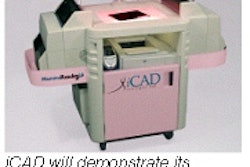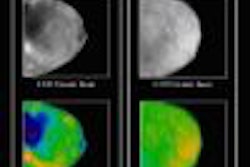Lower radiation dose could be another benefit of full-field digital mammography, as researchers trim exposure by as much as one-fourth compared to conventional film-screen breast imaging.
Two presentations at the 2002 RSNA meeting in Chicago discussed the possibility of dose reduction in FFDM. A group from Georg August University in Goettingen, Germany, conducted a clinical survey of average glandular dose using an FFDM system with an amorphous silicon flat-panel x-ray detector. A second group, from the University of Vienna in Austria, assessed the influence of reduced mAs on lesion marker placement.
"The average glandular dose is the mean value of the absorbed dose in the tissue of the uniformly compressed breast," said physicist Klaus-Peter Hermann, Ph.D., from Goettingen. The average glandular dose is calculated using conversion factor g, which depends mainly on radiation quality, breast thickness, and breast tissue components, he added.
The study was conducted during a four-month period using the Senographe 2000D system (GE Medical Systems, Waukesha, WI). The unit used featured a dual-track x-ray tube with a molybdenum (Mo) and rhodium (Rh) track on the anode, and either 0.03-mm Mo or 0.025-mm Rh filtration.
The patient population included 591 women, mean age 55, who were examined in screening and preventive settings. Overall, 1,116 exposures were taken, and only the craniocaudal projections were considered, Hermann said.
According to the results, the mean average glandular dose was 1.51 mGy for a single view. The mean compressed breast thickness was 55.7 mm. Hermann reported that the Rh anode with the Rh filter was the most common combination, chosen for 83.6% of the surveyed exposures. The mean value of the tube potentials was 29.4 kVp.
Hermann said his group identified the Rh anode and Rh filter combination with a kVp of 28 or higher as the standard radiation quality for FFDM. They concluded that with FFDM, it is possible to use higher energies and maintain image quality and contrast by adjusting the window settings. However, Hermann cautioned that the results of this study might not apply to other FFDM systems.
In a second study, the Vienna team used an FFDM system to take quality control mammograms after a clip or wire marker placement. Post-placement mammograms are particularly important because marker dislocation is a common problem, explained presenter Dr. Christopher Riedl.
"We thought it would be possible for a dose reduction (when verifying) the position of the marker to known lesions," Riedl said. "The purpose of our study was to assess the influence of reduced mAs on average glandular dose."
One hundred thirty-two control mammograms were performed in the craniocaudal and mediolateral views, with reduced mAs, on the Senographe 2000D. The study was composed of 66 consecutive cases undergoing preoperative hookwire localization or post-biopsy clip placement. The cases were divided into two groups, and two radiologists determined if the markers were visible on the reduced-mAs digital images, and if image quality was sufficient.
In group A, the mean reduced mAs was 53.5%; in group B, it was 74.5% from baseline exposure, Riedl reported. The mean average glandular dose reduction for group A was 63.9%, and 79.1% for group B. The radiologists found that the markers were visible on the FFDM images in all 66 cases. In group A, the quality of the control mammograms was sufficient for determining correct marker placement in 100% of the cases; in group B, the FFDM images were deemed sufficient in 93.9% of the cases.
"FFDM allows for the successful detection of markers and lesions despite a dose reduction of at least 50%," Riedl concluded.
Session moderator Dr. Carl Vyborny, Ph.D., asked Riedl whether he would recommend starting off with a lower dose for pre-marker placement images and then increase it, if necessary, for post-placement imaging.
"That’s what we do, actually," Riedl said. "We try it at 75% dose reduction and if that doesn’t work, then the 50% dose reduction is still a lower dose."
By Shalmali PalAuntMinnie.com staff writer
December 13, 2002
Related Reading
Post-biopsy gel marker stays put on mammographic follow-up, December 5, 2002
FFDM fares as well as screen-film for population-based breast screening, December 1, 2002
Even moderate doses of radiation may cause nervous system tumors, October 16, 2002
Is full-field digital mammography worth its weight in gold?, October 22, 2001
Copyright © 2002 AuntMinnie.com



















